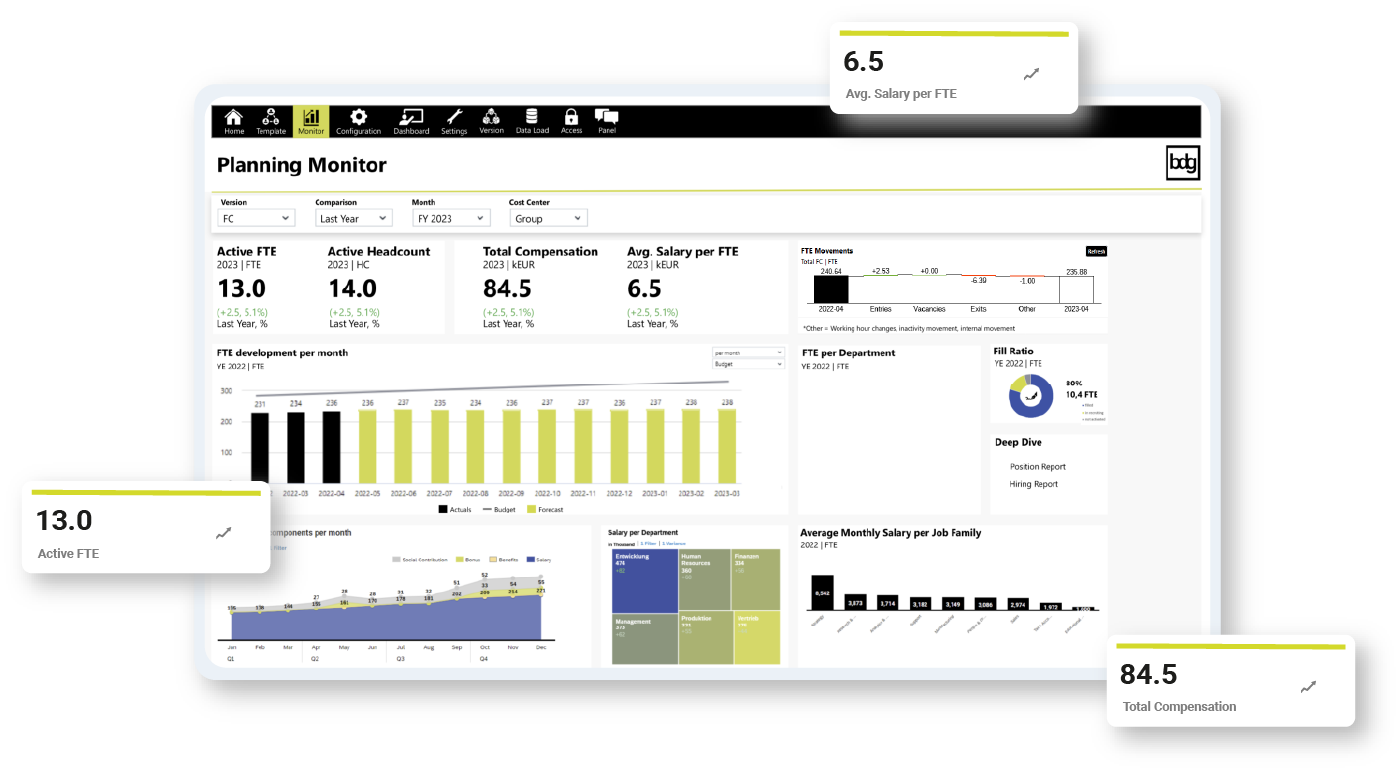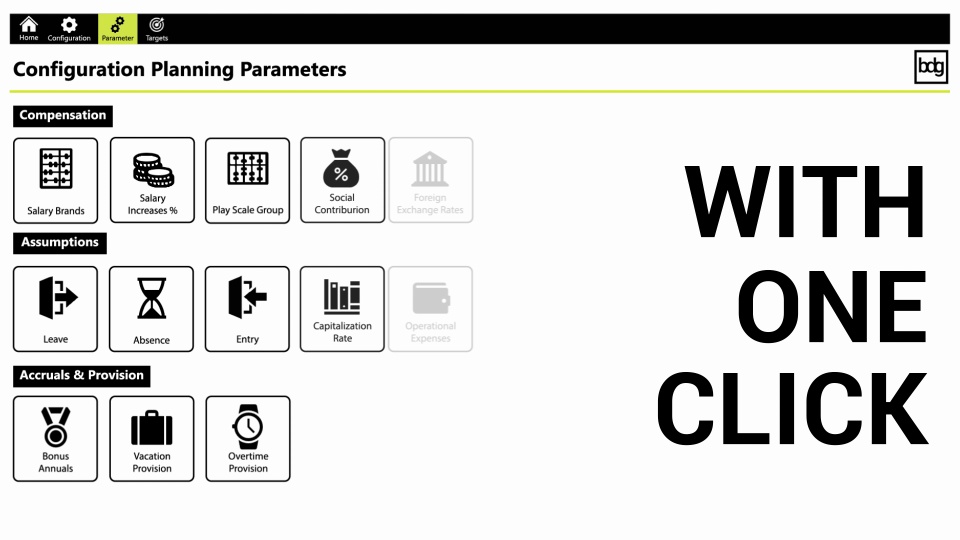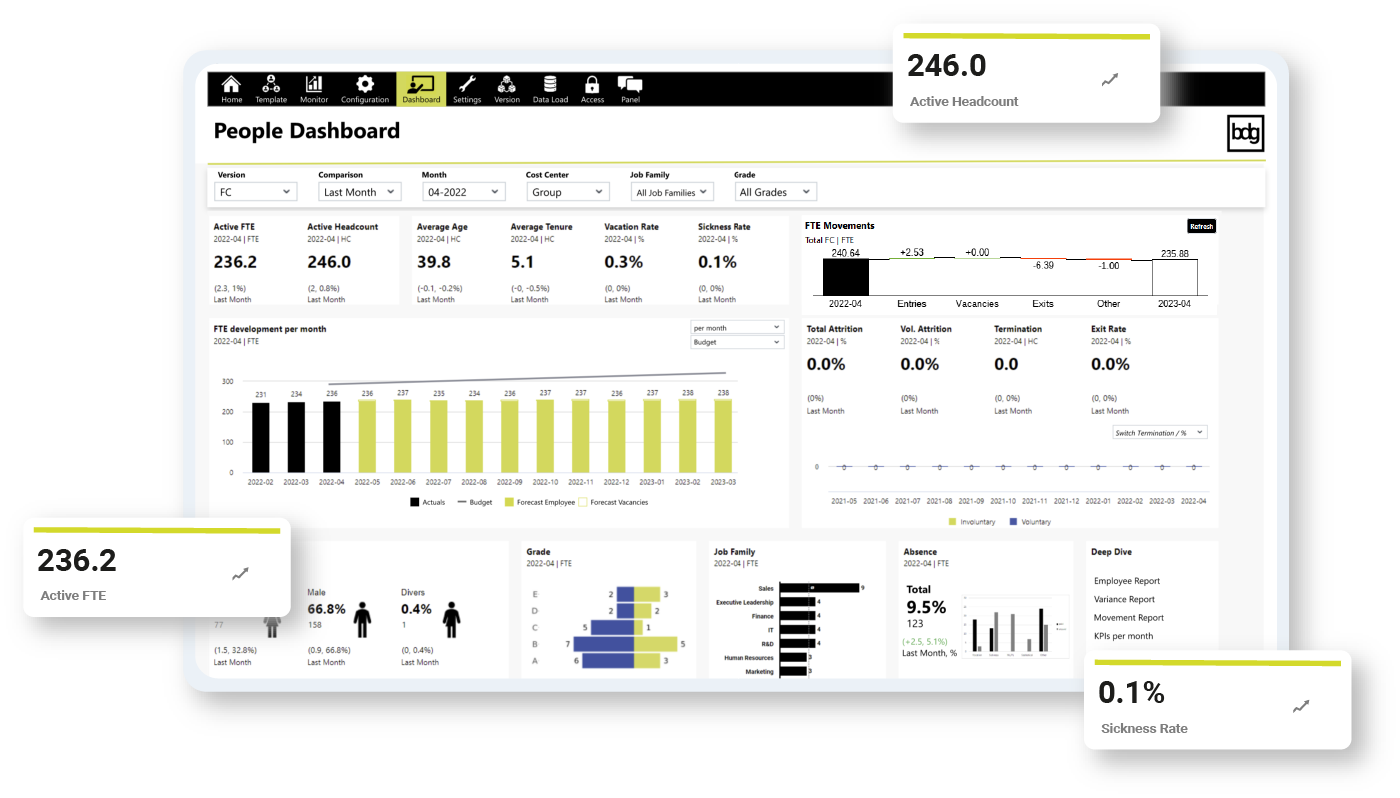HR-PLANNING WITH ANY HRMS
Plan and analyse your staffing needs based on your data in your HR-System.
From fully automated data integration to planning, budgeting and real-time aggregation for reporting, integrated workforce planning has never been easier or faster.

Empowering your HR-management tool
Countless companies use prolific tools in the HR-area. For good reason: dedicated HR-software can do almost everything, but integrated personnel planning is not yet possible on the vast majority of systems.
We are now making it possible on any platform. The video gives you a foretaste.

Data integration from and to your HRMS
No planning without data - we integrate your master and transaction data into a planning application via a ready-made and automated interface.
Load, transform, aggregate: In 3 steps, we turn your HR data into controlling tools in your HR-Management system. And to make planning fun for you, we deliver ...


Prefabricated planning functions
Calculate staffing requirements, plan cost centres, simulate scenarios, automatically create replacements and automatically assign salary bands as part of vacancy planning - the most important planning functions run immediately on the basis of your data in the application, ready to run.
Automatically reconcile your financial data
The planning application is able to map several clients and calculate currency effects. We offer the linking of your personnel and financial application, so that cost centres are automatically created in your financial planning during personnel planning, assigned to G/L accounts and transferred to the P&L. This means that you can plan at the level of headcounts or FTEs and the associated costs are automatically generated and planned on the basis of predefined parameters such as salary bands or personnel cost corridors.


Create management reports autmotically
Create a comprehensive business report from your plan data and your analytics. Headcounts, compensation measures, performance metrics and brand new: staff movements - all data is aggregated in real time and prepared as a business report, but you can also delve into the details at any time. Reporting, simply at the touch of a button.
HR-planning features: Ready to plan

Planning Wizard
The Planning Wizard is a planning assistant. It guides you step by step through the functions of the application for each action, ensures data consistency and even creates replacements automatically.

Vacancy optimisation
Plan salary bands to compensate for missing capacities internally through performance. Calculate realistic entry dates using a TTS matrix and link your recruiting module and other systems.

Cost centre allocation
Employees are planned on their corresponding cost centre to link financial planning in the best possible way. When switching between cost centres, the Planning Wizard helps - quickly and easily.

Analytics
Evaluate personnel analytic key figures. Sick leave, wage distribution, team composition, etc. in order to recognise trends at an early stage and derive the need for action.
HR-planning FAQ
What is part of human resource planning?
In short, human resource planning includes all processes that have the goal of calculating, achieving and then maintaining the ideal human resource situation. This is achieved through the holistic management of all human resources along the value chain.
For this purpose, human resource planners try to understand the entire employee lifecycle in order to anticipate needs and shortfalls and to cover the human resource requirements envisaged by the strategic growth targets. The better the planning, the better the implementation.
Which kinds of HR-Planning are there?
Staff redundancy planning: Takes place within the framework of staff requirement planning and includes not only staff reductions but also outplacement offers and the planning of severance budgets - this is where linking the finance area pays off.
Personnel development: Further and advanced training, potential analyses, retraining, candidate selection, the assessment of employees and the entire onboarding process fall within the scope of personnel development.
Personnel requirement planning: The supreme discipline, personnel requirement planning calculates from all available data how many employees are needed in which positions with which skills - now and in the future.
Recruitment planning: You have determined in personnel requirements planning that you need more people - so you start recruiting. All related processes fall under recruitment planning. With defined key figures, classically for example Time-To-Hire and Time-To-Fill, recruitment performance can also be measured and optimised accordingly.
Personnel cost planning: Salaries, salary bands and all ancillary wage costs and fringe benefits fall under the heading of personnel cost planning. Integrated personnel planning with bdg automatically generates the relevant cost centres in addition to the general personnel planning.
How do you do integrated HR-planning?
Integrated human resource planning is achieved by closely linking the planning processes in human resources with those of the finance department, which in turn are also linked to the organisational units that generate human resource requirements - production centres, departments, etc. The advantage of integrated human resource planning is that it makes it possible to identify human resource needs based on certain parameters, which are usually derived from strategic business planning, but also from other factors.
In fact, integrated human resource planning is only possible with appropriate planning applications, such as the one we are promoting here. The added value of such tools comes from the shortening of planning cycles with a simultaneous increase in planning quality as well as management consolidation and the immediately noticeable reduction in coordination rounds between management and decentralised organisational units.
How do you calculate staffing requirements?
In fact, this question is very complex, it has to be differentiated. Acute personnel needs in a certain occupational group can be calculated very easily on the surface. You only have two horn players in your orchestra, but the piece you are rehearsing calls for eight? There you have your personnel requirement - six.
For companies, it actually works the same way, only scaled across all company divisions and stretched over the entire planning period while taking various factors into account.
You calculate the basic staffing requirements from your available FTEs and the required FTEs for all occupational fields in all departments and then you approximate fluctuation, retirements, absences due to illness, parental leave, order cancellations, etc. using your personnel data or analytics to calculate the additional requirements. In many sectors, there are also seasonal extra requirements. And to be on the safe side, critical skills should generally be available redundantly, preferably distributed in different areas of operation. This way, you can counteract vacancies when they occur.
You need a powerful planning tool for personnel requirements planning, but it really gets down to the nitty-gritty when it comes to strategic personnel requirements planning.
What is strategic human resource demand planning?
Strategic HR demand planning goes one step further, taking the whole data set and calculating a multiplier based on your growth rate and your strategic goals. Many use special parameter matrices for scenario simulation for this.
The objective is, of course, to calculate at the strategic level, i.e. usually years in advance, when and where which skillsets are needed in which numbers in order to set the course accordingly at an early stage.
We use the tool XYZ, can you also connect that?
For our part, we can connect any pre-system. The prerequisite is that your tool provides a free API for developers, most do ... we have also linked most of them before. Challenges can arise with in-house developments, but we have a large repertoire of solutions and an experienced team that will find a way.
If in doubt, just ask.
What exactly does xP&A mean?
xP&A stands for "Extended Planning and Analytics" and essentially describes the idea of transferring planning and analysis processes that have been established in the finance department (FP&A, financial planning and analytics) to other departments within the company. Be it budgets, personnel costs, expenses or other data - every department in every company is connected to the finance department in one way or another. This connection is strengthened in xP&A approaches. It's about data aggregation, management consolidation and increased efficiency at all levels.
We would be happy to present this integration of the different areas in the context of our 'Collaborative and Connected Decision making Platform' in a demo, which you can book here on this page, among other places.
We keep improving. You should stay in touch!
Regster for the HR-Newsletter to stayinformed on developments in the realm of HR.